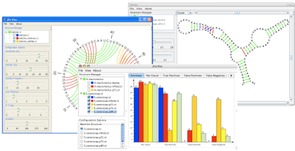I would describe myself as a computational intelligence researcher and bioinformatician with an interest in bioinformatics data visualization. The biological function of bio-molecules such as RNA is primarily determined by their structure. Physical structure determination methods are time consuming and expensive, hence computational methods for structure prediction are sought after. My current research focuses on the development of new algorithms for the prediction of the structure of bio-molecules, particularly RNA, and the development of tools and technologies for visualization and comparison of structures.
I have worked successfully in the areas of scientific computing, computer algebra, massively parallel computing, deterministic and non-deterministic algorithms including optimization and artificial intelligence. The current focus of my research is in the area of computational intelligence and visualization in bioinformatics.
The software RnaPredict, developed in my lab and based on evolutionary computation, has been demonstrated to predict certain known RNA secondary structures with very high accuracy and to have higher prediction accuracy on certain RNA sequences than mfold, the current benchmark for RNA secondary structure prediction.

While working with Biologists and Biochemists, I have learned that visual representation of vast amounts of data is of great importance, especially in the structure domain. In conjunction with my research group, I have developed a web based visualization tool for RNA structure visualization including pseudo-knots (jViz.Rna). Current work to extend jViz.Rna for visual comparison of structures using graph theory is under way. In addition, I am experimenting with new display technologies including stereoscopic 3D immersive environments. Our software jViz.Rna has certain benefits when compared to existing visualization tools. These include the ability to draw pseudo-knots in classical RNA structure diagrams, visually compare two structures, provide both quantitative and qualitative assessments, support a wide range of input and output formats, and to produce a dynamic visual output that can be further manipulated by the user.